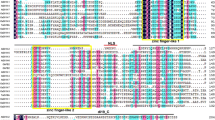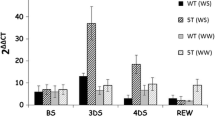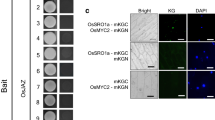Abstract
Members of the NAM-ATAF-CUC (NAC) protein family are plant-specific transcription factors that contain a highly conserved N-terminal NAC-domain and diverse C-terminal regions. They have been implicated in plant development and abiotic stress responses. To identify interacters of rice NAC-domain proteins (OsNACs), we performed yeast two-hybrid screening of rice cDNA library using OsNAC5 as a bait, and the results showed that OsNAC5 interacts with other OsNACs including itself. To delineate an interacting domain, a series of deletion constructs of four OsNACs were made and transformed into yeast in various combinations. The results revealed that the conserved NAC domain of OsNACs plays a primary role in homodimer and heterodimer formation, and a part of C-terminal sequence is also necessary for the interaction. In vitro pull-down assays using recombinant OsNAC proteins verified the dimer formations, together suggesting that OsNACs may act by forming homodimers and/or heterodimers in plants.





Similar content being viewed by others
References
Aida M, Ishida T, Fukaki H, Fujisawa H, Tasaka M (1997) Genes involved in organ separation in Arabidopsis: an analysis of the cup-shaped cotyledon mutant. Plant Cell 9:841–857
Collinge M, Boller T (2001) Differential induction of two potato genes, Stprx2 and StNAC, in response to infection by Phytophthora infestans and to wounding. Plant Mol Biol 46:521–529
Duval M, Hsieh TF, Kim SY, Thomas TL (2002) Molecular characterization of AtNAM: a member of the Arabidopsis NAC domain superfamily. Plant Mol Biol 50:237–248
Ernst HA, Olsen AN, Skriver K, Larsen S, Leggio LL (2004) Structure of the conserved domain of ANAC, a member of the NAC family of transcription factors. EMBO Rep 5:297–303
Fujita M, Fujita Y, Maruyama K, Seki M, Hiratsu K, Ohme-Takagi M, Tran L-SP, Yamaguchi-Shinozaki K, Shinozaki K (2004) A dehydration-induced NAC protein, RD26, is involved in a novel ABA-dependent stress-signaling pathway. Plant J 39:863–876
Greve K, La Cour T, Jensen MK, Poulsen FM, Skriver K (2003) Interactions between plant RING-H2 and plant-specific NAC (NAM/ATAF1/1/CUC2) proteins: RING-H2 molecular specificity and cellular localization. Biochem J 371:97–108
Hegedus D, Yu M, Baldwin D, Gruber M, Sharpe A, Parkin I, Whitwill S, Lydiate D (2003) Molecular characterization of Brassica napus NAC domain transcriptional activators induced in response to biotic and abiotic stress. Plant Mol Biol 53:383–397
Hu H, Dai M, Yao J, Xiao B, Li X, Zhang Q, Xiong L (2006) Overexpressing a NAM, ATAF, and CUC (NAC) transcription factor enhances drought resistance and salt tolerance in rice. PNAS 35:12987–12992
Nakashima K, Tran L-SP, Nguyen DV, Fujita M, Maruyama K, Todaka D, Ito Y, Hayashi N, Shinozaki K, Yamaguchi-Shinozaki K (2007) Functional analysis of a NAC-type transcription factor OsNAC6 involved in abiotic and biotic stress-responsive gene expression in rice. Plant J 51:617–630
Oh SJ, Kwon CW, Choi DW, Song SI, Kim JK (2007) Expression of barley HvCBF4 enhances tolerance to abiotic stress in transgenic rice. Plant Biotechnol J 5:646–656
Ooka H, Satoh K, Doi K, Nagata T, Otomo Y, Murakami K, Matsubara K, Osato N, Kawai J, Carninci P, Hayashizaki Y, Suzuki K, Kojima K, Takahara Y, Yamamoto K, Kikuchi S (2003) Comprehensive analysis of NAC family genes in Oryza sativa and Arabidopsis thaliana. DNA Res 20:239–247
Ren T, Qu F, Morris TJ (2000) HRT gene function requires interaction between a NAC protein and viral capcid protein to confer resistance to turnip crinkle virus. Plant Cell 12:1917–1926
Sablowski RW, Meyerowitz EM (1998) A homolog of NO APICAL MERISTEM is an immediate target of the floral homeotic genes APETALA3/PISTILLATA. Cell 92:93–103
Souer E, van Houwelingen A, Kloos D, Mol J, Koes R (1996) The no apical meristem gene of Petunia is required for pattern formation in embryos and flowers and is expressed at meristem and primordia boundaries. Cell 85:159–170
Tran LS, Nakashima K, Sakuma Y, Simpson SD, Fujita Y, Maruyama K, Fujita M, Seki M, Shinozaki K, Yamaguchi-Shinozaki K (2004) Isolation and functional analysis of Arabidopsis stress-inducible NAC transcription factors that bind to a drought responsive cis-element in the EARLY RESPONSIVE TO DEHYDRATION STRESS 1 promoter. Plant Cell 16:2481–2498
Weir I, Lu J, Cook H, Causier B, Schwarz-Sommer Z, Davies B (2004) CUPULIFORMIS establishes lateral organ boundaries in Antirrhinum. Development 131:915–922
Xie Q, Sanz-Burgo AP, Guo H, Garcia JA, Gutierrez C (1999) GRAB proteins, novel members of NAC domain family, isolated by their interaction with geminivirus protein. Plant Mol Biol 39:647–656
Xie Q, Frugis G, Colgan D, Chua NH (2000) Arabidopsis NAC1 transduces auxin signal downstream of TIR1 to promote lateral root development. Genes Dev 14:3024–3036
Acknowledgment
This work was supported by the Ministry of Education, Science and Technology, Korea, through the Crop Functional Genomics Center (CG2111 to J.-K.K) and Biogreen21 (to J.-K.K).
Author information
Authors and Affiliations
Corresponding author
Rights and permissions
About this article
Cite this article
Jeong, J.S., Park, Y.T., Jung, H. et al. Rice NAC proteins act as homodimers and heterodimers. Plant Biotechnol Rep 3, 127–134 (2009). https://doi.org/10.1007/s11816-009-0081-z
Received:
Accepted:
Published:
Issue Date:
DOI: https://doi.org/10.1007/s11816-009-0081-z




